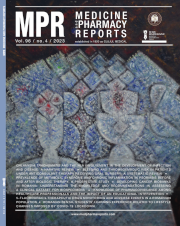TP53 gene implications in prostate cancer evolution: potential role in tumor classification
DOI:
https://doi.org/10.15386/mpr-2639Keywords:
prostatic neoplasms, adenocarcinoma, microRNAs, biomarkersAbstract
Background and aims. Prostate adenocarcinoma (PRAD) is a complex disease that can be driven by alterations in both coding and noncoding genes. Recent research has identified coding and non-coding genes that are considered to play important roles in prostate cancer evolution and which may be used as biomarkers for disease diagnosis, prognosis, and treatment. TP53 is a critical hub gene in prostate cancer. Advanced studies have demonstrated the crosstalk between coding and non-coding RNAs, particularly microRNAs (miRNAs).
Methods. In this study, we investigated the roundabout of TP53 and their regulatory miRNAs (miR-15a-5p, miR-34a-5p, and miR-141-3p) based on the TCGA data set. We validated an additional patient cohort of 28 matched samples of patients with PRAD at tissue and plasma level.
Results. Therefore, using the UALCAN online database, we evaluated the expression level in PRAD of these genes revealing overexpression of TP53. qRT-PCR validation step endorsed the expression level for these genes. Additionally, we evaluated the expression level of the four key miRNAs (miR-15a-5p, miR-34a-5p, and miR-141-3p) interconnected as a network at tissue and plasma levels.
Conclusions. Through these results, we demonstrated the essential function of TP53 and its associated miRNAs that play a significant role in tumor control, highlighting miRNAs’ potential as future therapeutic targets and biomarkers with important implications in managing prostate cancer.
Downloads
Published
How to Cite
Issue
Section
License
The authors are required to transfer the copyright of the published paper to the journal. This is done by agreeing to sign the Copyright Assignment Form. Whenever the case, authors are also required to send permissions to reproduce material (such as illustrations) from the copyright holder.

The papers published in the journal are licensed under a Creative Commons Attribution-NonCommercial-NoDerivatives 4.0 International License.

